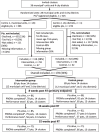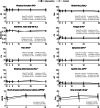Geriatric assessment with management for older patients with cancer receiving radiotherapy: a cluster-randomised controlled pilot study
- PMID: 38853251
- PMCID: PMC11163782
- DOI: 10.1186/s12916-024-03446-4
Geriatric assessment with management for older patients with cancer receiving radiotherapy: a cluster-randomised controlled pilot study
Abstract
Background: Geriatric assessment and management (GAM) improve outcomes in older patients with cancer treated with surgery or chemotherapy. It is unclear whether GAM may provide better function and quality of life (QoL), or be cost-effective, in a radiotherapy (RT) setting.
Methods: In this Norwegian cluster-randomised controlled pilot study, we assessed the impact of a GAM intervention involving specialist and primary health services. It was initiated in-hospital at the start of RT by assessing somatic and mental health, function, and social situation, followed by individually adapted management plans and systematic follow-up in the municipalities until 8 weeks after the end of RT, managed by municipal nurses as patients' care coordinators. Thirty-two municipal/city districts were 1:1 randomised to intervention or conventional care. Patients with cancer ≥ 65 years, referred for RT, were enrolled irrespective of cancer type, treatment intent, and frailty status, and followed the allocation of their residential district. The primary outcome was physical function measured by the European Organisation for Research and Treatment of Cancer Quality of Life Questionnaire-C30 (QLQ-C30). Secondary outcomes were overall quality of life (QoL), physical performance, use and costs of health services. Analyses followed the intention-to-treat principle. Study registration at ClinicalTrials.gov ID NCT03881137.
Results: We included 178 patients, 89 in each group with comparable age (mean 74.1), sex (female 38.2%), and Edmonton Frail Scale scores (mean 3.4 [scale 0-17], scores 0-3 [fit] in 57%). More intervention patients received curative RT (76.4 vs 61.8%), had higher irradiation doses (mean 54.1 vs 45.5 Gy), and longer lasting RT (mean 4.4 vs 3.6 weeks). The primary outcome was completed by 91% (intervention) vs 88% (control) of patients. No significant differences between groups on predefined outcomes were observed. GAM costs represented 3% of health service costs for the intervention group during the study period.
Conclusions: In this heterogeneous cohort of older patients receiving RT, the majority was fit. We found no impact of the intervention on patient-centred outcomes or the cost of health services. Targeting a more homogeneous group of only pre-frail and frail patients is strongly recommended in future studies needed to clarify the role and organisation of GAM in RT settings.
Keywords: Cancer; Frailty; Geriatric assessment with management; Older patients; Radiotherapy; Randomised controlled trial.
© 2024. The Author(s).
Conflict of interest statement
The authors declare that they have no competing interests.
Figures



References
-
- WHO. World report on ageing and health 2015. Available from: https://apps.who.int/iris/handle/10665/186463. Accessed 1 Aug 2023.
-
- World Population Prospects 2022: United Nations Department of Economic and Social Affairs, Population Division. Available from: https://www.un.org/development/desa/pd/sites/www.un.org.development.desa.... Accessed 25 Jan 2022.
Publication types
MeSH terms
Associated data
LinkOut - more resources
Full Text Sources
Medical

